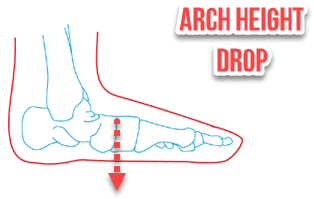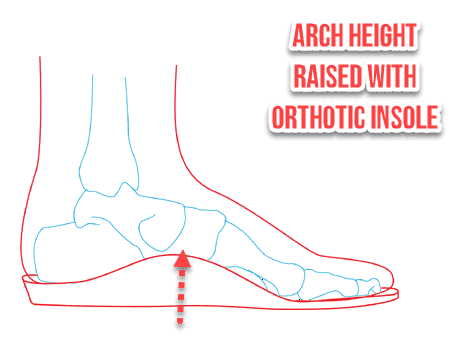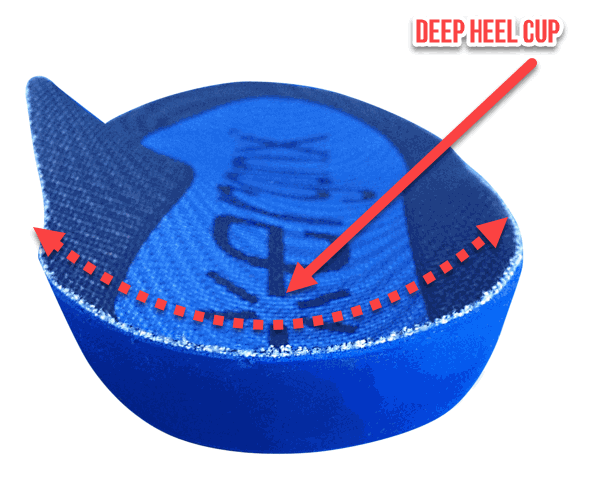The sharp pain in the morning that makes you limp for a few steps but then improves is often plantar fasciitis.
Shop online for our most popular orthotics for plantar fasciitis
-
Ergonx Ultra Soft
Regular price $49.95 AUDRegular priceUnit price per -
Dual Density
Regular price $69.95 AUDRegular priceUnit price per -
Ergonx 3 Quarter
Regular price $39.95 AUDRegular priceUnit price per -
Ergonx Slimline
Regular price $39.95 AUDRegular priceUnit price per -
Ergonx Sports
Regular price $39.95 AUDRegular priceUnit price per
Podiatrist Review

Plantar view of the plantar fascia pain
What is Plantar Fasciitis?
Plantar fasciitis is an inflammation of the plantar fascia ligament that spans the arch from the heel to the forefoot and can cause considerable foot pain.
When the foot overpronates and the arch collapses the plantar ligament is placed under excessive strain and develops micro tears or microtrauma. The plantar ligament then becomes inflamed and is referred to as “plantar fasciitis”.
When the plantar ligament is inflamed it can be painful anywhere from the inside of the heel (heel pain), arch pain or heel pressure to the ball of the foot just behind the first toe. This is why the terms plantar fasciitis heel pain are often used interchangeably.

What causes plantar fasciitis pain?
How does overpronation strain the plantar fascia
When the foot is in a neutral (level) position the arch is at its full height. As the foot rolls towards the midline of the body the arch drops (also known as fallen arches). Overpronation can affect both high arches and low arches, however heel pain and plantar fasciitis pain are more commonly associated with flat feet. The extent of the arch collapse (how far the arch drops) usually plays a part in how much strain is placed on the plantar fascia during this drop. The bigger the drop the greater the strain. So the foot with a high arch is also susceptible to strain.
As the arch height drops the foot elongates and the load on the plantar ligament is increased.
A strong arch support orthotic insole will help to limit over pronation, arch collapse and strain on the plantar ligament.

When the height drops it’s creates strain on the plantar ligaments and arch
Why does plantar fasciitis hurt first thing in the morning?
As we rest our feet, like we do when we are asleep or after a long drive in the car, the plantar ligament cools and shortens and stiffens. When we stand on the foot for the first time after resting, the plantar ligament is shortened but the arch height will still collapse and over pronate the usual amount. This creates a greater strain in the plantar structures compared to when the plantar ligament was warmed up. As we walk on the foot the plantar structures will become more flexible and the pain relief from the decrease in tension will be felt after a few steps.

Plantar fasciitis orthotics are aimed at supporting the arch and limiting the strain on the plantar ligament and arch.
The aim of treatment for plantar fasciitis with orthotic insoles
The aim of treatment of plantar fasciitis inserts is to reduce the tension in the plantar ligament, rest the foot and allow it to heal. This will often lead to relief from plantar fasciitis. Anything that causes there to be an excessive strain in the foot needs to be limited (temporarily) to allow the plantar ligament to heal.
Plantar fasciitis orthotic insoles will help to support the arch of the foot, limit strain on the foot and cushion the painful ligament attachment site, resulting in heel pain relief.
Plantar fasciitis orthotics important features
For an orthotic insole to treat plantar fasciitis pain, it needs to both support and cushion the foot. If we do both of these things well, we will get pain relief from plantar fasciitis and foot pain. If you suffer from plantar fasciitis, orthotic insoles for plantar fasciitis with the features below will help with pain relief.

The best insoles support the arch shape of the foot
Arch support
Plantar fasciitis insoles should provide stability, support and cushion the foot. By supporting the arch of the foot we limit the strain on the arch and decrease the healing time. Arch support helps to rest the plantar ligament and allows the body to heal. Similar to how a plaster cast would rest a broken arm, arch support plantar fasciitis insoles rest the plantar fascia and the entire foot. This makes the foot more comfortable.

It’s important to cushioning the heel bone
Heel cushioning poron pads for pressure relief
Plantar fasciitis orthotic insoles that cushion the heel help to reduce heel pain by making it more comfortable to walk immediately. The site where the plantar ligament is attached to the heel bone is unfortunately a weight-bearing area of the foot. Up to 4 times your body weight passes through the heel as our heel strikes the ground. By cushioning the location where the plantar ligament attaches in the calcaneus (heel bone), we make the foot more comfortable in those that suffer from plantar fasciitis.

Where possible, cushion the foot pressure points
Cushioning Poron pads to slow reaction forces on the entire foot
Orthotic insoles for plantar fasciitis should also cushion the entire foot to make the foot more comfortable. By using cushioning Poron pads at the high-impact areas of the foot, we increase cushioning (poron is a great shock absorber)and decrease the weight of the insole (poron is heavy). This makes the foot more comfortable across the day.

Deep heel cups support the natural fatty pad of the heel
Deep heel cup for extra cushioning
Orthotic insoles that cushion the heel help to reduce heel pain by making it more comfortable to walk immediately. The site where the plantar fascia is attached to the heel bone is unfortunately a weight-bearing area of the foot. Up to 4 times your body weight passes through the heel as our heel strikes the ground. By cushioning the location where the plantar fascia attaches in the calcaneus (heel bone), we make the foot more comfortable in those that suffer from plantar fasciitis.

Arch support helps prevent foot pain
Lateral arch support for stability, pronation control and extra cushioning
Orthotic insoles for plantar fasciitis should offer arch support to all of the arches in the foot. This promotes foot stability and also increases cushioning as the load of walking is spread over the entire surface area of the foot.

Soft but responsive materials help to stop jarring pain
Soft premium cushioned PU foam for instant comfort
Supportive yet flexible orthotic insoles are generally more comfortable than hard orthotics. By using a premium soft PU foam we are able to offer strong arch support but not have that arch support be overwhelming and uncomfortable.
Overall features of plantar fasciitis orthotic insoles
Inserts for plantar fasciitis that have all of the above features will be beneficial to the treatment of plantar fasciitis. Maintaining the arch height, decreasing the forces that are acting on the foot (through cushioning) and aligning the feet with orthotic support will improve your overall foot health and comfort.

About the Author
Kent Elliot (Podiatrist). B App. Sc. Pod (Hons), B.Sc(HMS). M.A. Pod. A
Kent graduated from the University of Queensland with a Bachelor of Science (majoring in Human Movement Studies) and from Podiatry at The Queensland University of Technology (QUT). During this time Kent took a special interest in exercise and conditioning training, orthotics, and heel pain. Kent has a personal interest in and has participated in many sports including rugby, athletics, boxing, tennis, and running.











